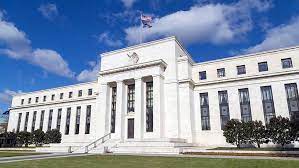The Federal Reserve interest rates rose in US significantly on Wednesday, hiking it 0.75%, escalating a strategy of increased borrowing costs that aims to dial back historic inflation.
The Federal Reserve interest rate hike of 0.75% marks the largest increase since 1994. The dramatic rate increase follows new inflation data that showed a reacceleration of price increases to levels not seen for more than four decades, dashing hopes that inflation had reached its peak.
“We at the Fed understand the hardship that high inflation is causing and we’re strongly committed to bringing inflation back down,” Federal Reserve Chair Jerome Powell said on Wednesday.
The Federal Reserve “anticipates ongoing
increases” in its benchmark interest rate, he added.
The Federal Reserve interest rate hike of
0.75% brings the interest rate to a range of 1.5% to 1.75%
"The invasion of Ukraine by Russia is
causing tremendous human and economic hardship," the Federal Reserve said
in a statement on Wednesday. "The invasion and related events are creating
additional upward pressure on inflation and are weighing on global economic
activity. In addition, COVID-related lockdowns in China are likely to
exacerbate supply chain disruptions."
"The Committee is highly attentive to
inflation risks," the central bank added.
The Fed also indicated that more rate hikes
will follow in the coming months.
An increase to the benchmark interest rate
raises borrowing costs for consumers and businesses, which in theory should
slash inflation by slowing the economy and eating away at demand. But the
strategy also risks tipping the economy into a recession. The rate hike will
likely increase everything from credit card fees to mortgage rates.
The Federal Reserve interest rate raised its
benchmark by 0.5% last month, and central bankers had signaled the same
increase for June. But a persistent surge in costs appears to have prompted a
reevaluation. The consumer price index, or CPI, stood at 8.6% year-over-year in
May, a significant increase from 8.3% the month prior, according to data
released by the U.S. Bureau of Labor Statistics on Friday.
In a statement, the Federal Reserve said it's
"strongly committed to returning inflation to its 2 percent
objective."
President Joe Biden has touted the economic
recovery from a coronavirus-induced downturn, but acknowledged that many
American households are struggling with high costs.
What Is The Federal Reserve?
Established by Congress and President Woodrow
Wilson at the end of 1913, the Federal Reserve is the central bank of the
United States. The Federal Reserve Act established a few key goals for the bank
that still serves as its purpose today.
The missions of the Federal Reserve are to
create an environment that leads to as many people being employed as possible,
stabilize prices for goods and services and moderate interest rates over time,
which has a direct impact on the other two missions.
In addition, the Fed serves as an important
regulator for much of the entire U.S. banking system. We’ll focus on the
missions of employment and stable prices and how they relate to interest rates
for the rest of this article.
The Federal Open Market Committee (FOMC) is the
chief decision-making board within the Federal Reserve that sets monetary
policy aimed to achieve the Fed’s goals. Its decisions on the movement of
short-term interest rates and spending the money under its control have a big
impact on many areas of the economy, and mortgage rates are no exception.
How the Federal Reserve Generally Affects Interest Rates
The Fed holds two main tools it uses to
influence interest rates: first, its direct control of short-term interest
rates; second, its direct influence on mortgage rates with its purchase and
sale of mortgage-backed securities (MBS).
The FOMC has direct control over something
called the federal funds rate. This is the rate at which banks borrow from each
other when they need funds overnight. The rate is currently in a range between
0% and 0.25%.
This rate typically has the biggest impact on
short-term credit with variable interest, such as a consumer credit card. In
this case, the federal funds rate may be added to a margin and personal factors
that contribute to your interest rate. And although not directly impacting
rates for longer-term loans like mortgages, the two often move in the same
direction.
Why
is the Fed raising interest rates?
Short-term interest rates in the U.S. are now
essentially zero.
The Fed quickly cut rates to zero at the
beginning of the COVID-19 crisis in March 2020 in an attempt to soften the blow
of the sharp recession that began that month as the U.S. went into lockdown. As
a reminder of how bad things were back then, over 40 million workers – a
quarter of the American workforce – filed for unemployment in the first few
months of the pandemic, a staggering number with no precedent in the job
market.
Although the recession was short-lived –
lasting only two months – and the economy has mostly recovered, the Fed has
kept rates at rock bottom because many workers and businesses still need support
as the pandemic continues to rage.
The big problem for the Fed now is that U.S.
consumer prices have surged. For 10 months in a row, inflation has been above
the Fed’s 2% target and reached an annual pace of about 7% in December. This is
the highest rate of inflation recorded in the U.S. in the last 40 years. High
inflation means the prices people pay for goods and services are continually
going up – especially for basic items like meat and gasoline, as well as for
manufactured goods like cars.
The Fed can ill afford to allow this to
continue because if higher inflation becomes entrenched, it would damage the
economy. And the longer it lasts, the harder – and more painful for consumers
and businesses – it is going to be to bring it back to a more sustainable 2%.
So the Fed has to act quickly before it’s too
late.











0 Comments